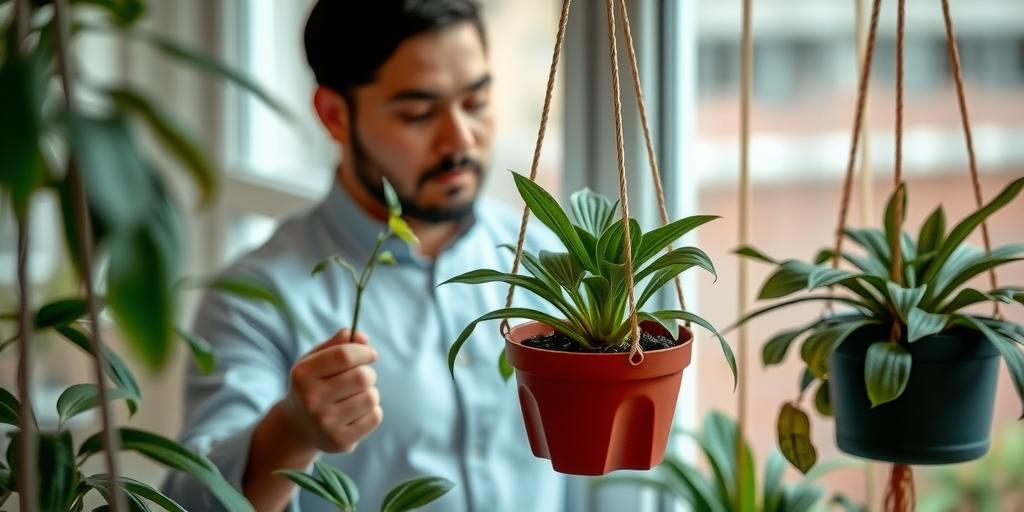
How to Water Hanging Plants in Low Light: A Step-by-Step Guide (2025)
Struggling to keep your hanging plants thriving in low light? Learn how to water them properly with this step-by-step guide, ensuring healthy growth even in dim spaces!
Introduction
Did you know that over 60% of indoor plant issues stem from improper watering—especially in low-light conditions? Hanging plants add a touch of greenery to any space, but without enough sunlight, their watering needs change. Whether you’re caring for a pothos, spider plant, or fern, this guide will walk you through the best practices for watering hanging plants in low light. Let’s dive in and keep your plants lush and happy!
Understanding Low-Light Hanging Plants’ Watering Needs
Why Low-Light Plants Need Different Watering Routines
Low-light hanging plants don’t get as much sunlight as their sun-loving counterparts, which means they photosynthesize at a slower rate. This slower growth directly impacts how much water they use—less light equals less water consumption. Overwatering is the biggest risk here because soggy soil in dim conditions can lead to root rot before you even notice the problem.
Common Signs of Overwatering vs. Underwatering
Spotting the difference between overwatering and underwatering can be tricky, but here’s what to look for:
-
Overwatering: Yellowing leaves, mushy stems, a musty smell from the soil, or fungus gnats hovering around the pot.
-
Underwatering: Crispy, brown leaf edges, drooping stems, and soil pulling away from the edges of the pot.
If you’re unsure, check the soil before reaching for the watering can—more on that later.
How Light Levels Affect Soil Moisture Retention
Low-light conditions slow down evaporation, meaning soil stays damp longer. This is why a plant in a shady corner might only need water every 10–14 days, while the same plant near a bright window might dry out in a week. Always factor in light exposure when planning your watering schedule.
Choosing the Right Watering Tools
Best Watering Cans for Hanging Plants
Hanging plants can be tricky to water without making a mess. A long-spouted watering can gives you precision to reach soil directly without splashing leaves—great for plants like pothos or philodendrons. For delicate ferns or air plants, a mister helps maintain humidity without over-saturating the roots.
Self-Watering Systems for Low-Maintenance Care
If you’re forgetful or travel often, self-watering systems are a lifesaver. Options include:
-
Globes or spikes that slowly release water.
-
Wicking systems where a cord draws water from a reservoir into the soil.
-
Hanging planters with built-in water reservoirs (like those from brands like Lechuza).
Just be cautious—self-watering doesn’t mean “no maintenance.” Check soil moisture occasionally to avoid overdoing it.
The Role of Humidity Trays and Pebble Trays
Many low-light hanging plants (e.g., ferns, calatheas) thrive in humid air. A pebble tray filled with water beneath the pot boosts moisture levels without waterlogging roots. Alternatively, group plants together to create a mini-humid microclimate.
Step-by-Step Watering Guide for Low-Light Hanging Plants
How to Check Soil Moisture Accurately
Skip guesswork with these methods:
-
Finger test: Push your finger 1–2 inches into the soil. If it’s dry, water; if damp, wait.
-
Moisture meter: A $10 tool that gives a precise reading—ideal for beginners.
The Best Time of Day to Water Hanging Plants
Morning is ideal. Watering early allows excess moisture to evaporate during the day, reducing the risk of fungal growth. Avoid nighttime watering, as stagnant water in cool, dark hours invites mold.
Proper Watering Techniques to Avoid Root Rot
-
Water slowly and evenly until you see drainage from the pot’s holes.
-
Empty the saucer or cache pot afterward—no plant likes wet feet!
-
For plants like succulents or snake plants, let soil dry completely between waterings.
Adjusting Frequency Based on Season and Plant Type
-
Summer: Plants may need more frequent watering (but still check soil first!).
-
Winter: Reduce watering—some plants go semi-dormant in low light and cold.
-
Tropical plants (e.g., monsteras): Prefer consistently moist (not soggy) soil.
-
Succulents or ZZ plants: Thrive on neglect—water sparingly.
Best Water Types for Healthy Hanging Plants
Tap Water vs. Filtered/Rainwater: Which Is Best?
-
Tap water: Convenient, but chlorine or fluoride can harm sensitive plants (e.g., spider plants, dracaenas). Let it sit overnight to dissipate chemicals.
-
Filtered or rainwater: Ideal for fussy plants like orchids or carnivorous species.
The Impact of Water Temperature on Plant Health
Cold water can shock roots, while hot water harms beneficial microbes. Room-temperature water is the sweet spot.
Should You Use Fertilizer When Watering?
In low light, plants grow slower and need less fertilizer. If you do fertilize:
-
Dilute to half-strength to avoid salt buildup in soil.
-
Only fertilize in spring/summer—skip winter unless the plant is under grow lights.
Common Mistakes to Avoid
Overwatering in Low Light (And How to Fix It)
The #1 killer of hanging plants! If you’ve overwatered:
-
Stop watering and let soil dry out.
-
Trim rotten roots (black/mushy) and repot in fresh, well-draining mix.
-
Move the plant to a brighter spot temporarily to speed up drying.
Ignoring Drainage Holes and Soil Quality
No drainage? Disaster waiting to happen. Always use pots with holes and airy, well-draining soil (add perlite or orchid bark to regular potting mix).
Forgetting to Rotate Plants for Even Growth
Low-light plants stretch toward light sources. Rotate them 90° every few weeks to prevent lopsided growth.
Troubleshooting Unhealthy Hanging Plants
Yellow Leaves? Drooping Stems? Diagnosing the Issue
-
Yellow leaves + wet soil: Overwatering.
-
Yellow leaves + dry soil: Underwatering or nutrient deficiency.
-
Drooping stems: Could be thirst (dry soil) or drowning (soggy soil).
How to Revive an Overwatered or Dehydrated Plant
-
Overwatered: Repot, trim dead roots, and reduce watering.
-
Dehydrated: Soak the pot in a tray of water for 30 minutes (for severely dry plants).
When to Repot vs. Adjust Watering Habits
-
Repot if roots are circling the pot or poking through drainage holes.
-
Adjust watering if the plant is otherwise healthy but showing moisture stress. Sometimes, a simple schedule tweak is all it needs!
Conclusion
Watering hanging plants in low light doesn’t have to be tricky! By understanding their unique needs, using the right tools, and avoiding common mistakes, you can keep your greenery thriving. Start implementing these tips today, and watch your plants flourish—even in the shadiest corners of your home. Have questions? Drop them in the comments below!
